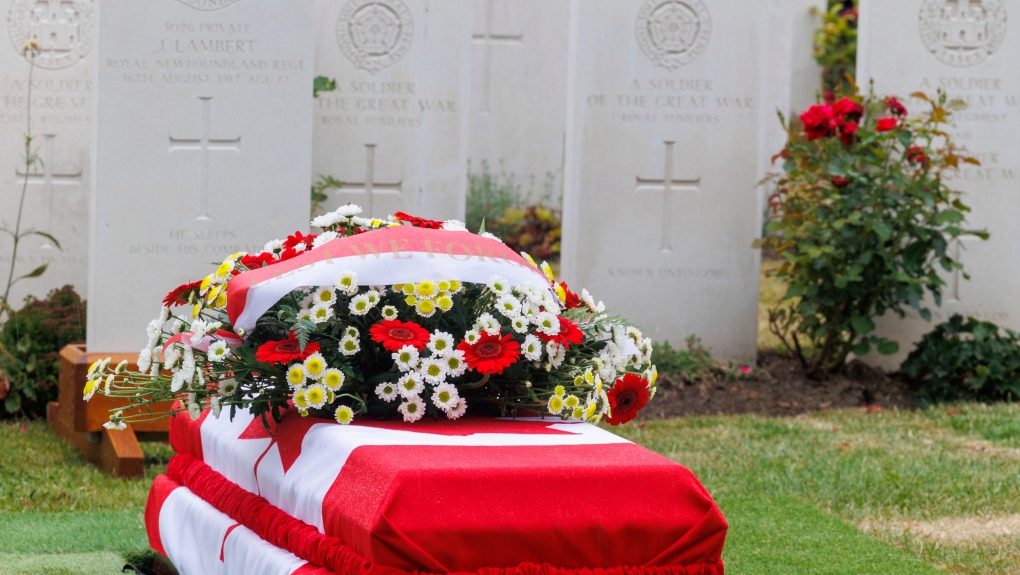For more than 100 years, the family of Pte. John Lambert knew he died fighting in the First World War, but never knew what happened to his body.
Known as “Jack” to family, Lambert lied about his age to enlist as a 16-year-old in the Newfoundland Regiment on August 14, 1916.
His battalion served with the 88th Brigade of the 29th Infantry Division of the British Expeditionary Force.
On Aug. 16, 1917, Lambert and the Newfoundland Regiment were assigned to capture a portion of the German line, an effort known as the Battle of Langemarck, in Belgium.
While his unit captured its objective, Pte. Lambert died of his battle wounds, according to his personnel file.
“My father often spoke about him and said that he must have been blown to bits in the war,” said Anne Smith, Lambert’s niece. “That was his way of trying to explain why he didn't come back.”
Smith’s father, James Lambert, died in 1982, without knowing what happened to his older brother.
“He never had a final resting place,” said Smith. “And my father was always troubled by that.”
The whereabouts of Pte. Lambert's body seemed lost to time, until a team of archeologists uncovered the remains of four soldiers near St. Julien, Belgium.
Three turned out to be British soldiers, and one had a shoulder tile with the letters NFLD, from a First World War Newfoundland Regiment uniform.
“Pte. John Lambert was admittedly one of more complicated cases that I personally faced,” said Sarah Lockyer, the Canadian Armed Forces Casualty Identification Program’s forensic anthropologist. “Mostly because he was found with three other individuals and their remains were mixed together.”
Lockyer says since Lambert’s bones were younger, it was easier to separate them from the other remains.
 The coffin of World War I soldier, Canadian Private John Lambert of the Newfoundland Regiment, is covered with flowers during a burial ceremony with full military honors at the Irish Farm Commonwealth War Graves Cemetery in Ypres, Belgium, on Thursday June 30, 2022. Seven World War I soldiers received a ceremonial reburial on Thursday. The remains were discovered near Ypres during a gas pipeline construction. (AP Photo/Olivier Matthys)The Casualty Identification Team then had to search for living relatives for 16 missing Newfoundlanders from that battle.
The coffin of World War I soldier, Canadian Private John Lambert of the Newfoundland Regiment, is covered with flowers during a burial ceremony with full military honors at the Irish Farm Commonwealth War Graves Cemetery in Ypres, Belgium, on Thursday June 30, 2022. Seven World War I soldiers received a ceremonial reburial on Thursday. The remains were discovered near Ypres during a gas pipeline construction. (AP Photo/Olivier Matthys)The Casualty Identification Team then had to search for living relatives for 16 missing Newfoundlanders from that battle.
“We got lucky, we were able to find a DNA donor for Pte. Lambert,” said Lockyer. “And the results were positive for him.”
That sample came from Lambert’s cousin, 91-year-old Patricia Egan.
The family officially found out it was a match on Dec. 1, 2020.
“We were all awestruck we just couldn't believe it,” said Smith.
Lambert was buried at the New Irish Farm Cemetery in West-Vlaanderen, Belgium, on June 30, 2022. Current members of the Royal Newfoundland Regiment carried his casket.
It was a moment Smith wishes her father could have seen.
“I know that he would have been extremely pleased that he finally had a resting place for his brother,” said Smith.
There are more than 27,000 unknown soldiers who fought in 20th century wars, most of whom fought during the First World War.
Lockyer says she uses artifacts, records, and DNA to try to confirm their identities. Still it’s time consuming, difficult work.
“Since 2007 the program as been able to successfully identify 35 sets of remains,” said Lockyer. “We've had to bury eight as unknown soldiers.”








































